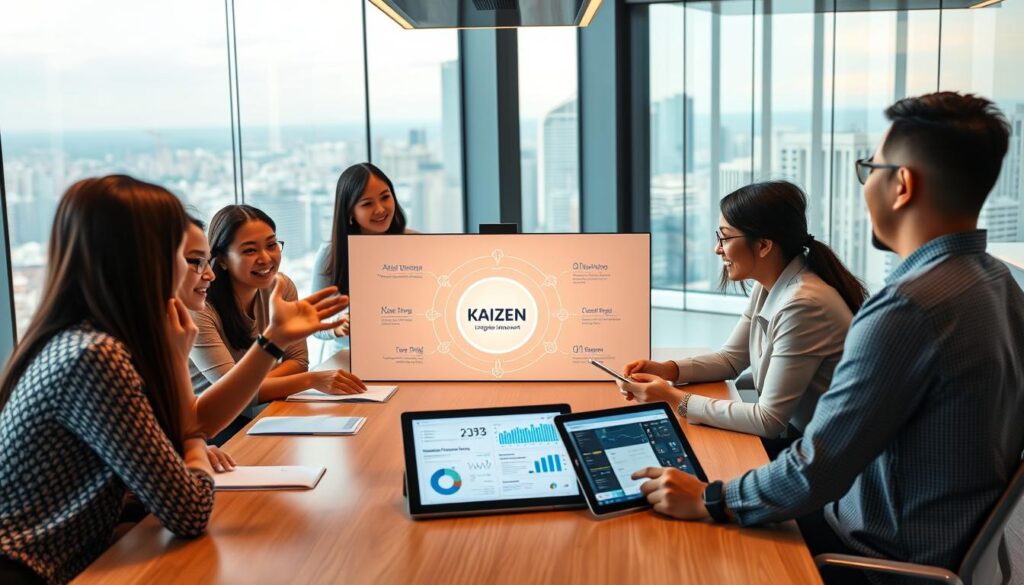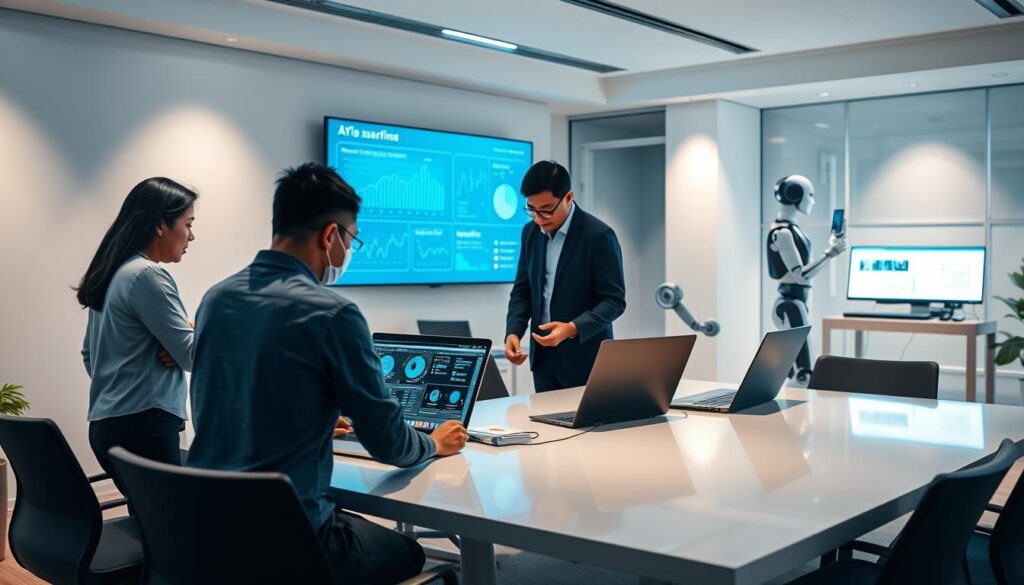Ever thought about how continuous improvement can change your AI projects? By using Kaizen for AI, companies can find new ways to improve. This Japanese method focuses on always getting better. When applied to AI, it cuts waste and boosts business value.
In this section, we’ll see how continuous improvement can help you succeed. It’s key in today’s fast world.
Key Takeaways
- Understanding the synergy between Kaizen principles and AI.
- Emphasizing the role of continuous improvement in operational success.
- Identifying the unique value of AI optimization through data and automation.
- Recognizing the importance of sustainable practices in AI project management.
- Implementing effective continuous improvement strategies for long-term benefits.
The Essence of Kaizen in AI Projects
The Kaizen methodology is all about making things better all the time. It’s a great fit for today’s AI projects. It helps get rid of waste and makes things more efficient. This way, teams can keep getting better and better.
In AI, Kaizen helps teams make their tech better and better. They get feedback to see how they’re doing. This makes their work more efficient and helps them meet their goals faster.
Using Kaizen in AI projects creates a culture that loves to improve. Everyone gets involved in making things better. This leads to quick wins and long-term growth for the company.
Understanding Continuous Improvement & Feedback Loops
In AI development, continuous improvement loops and feedback systems are key. They make AI work better and faster. This helps companies find new ways to solve problems.
The Role of Continuous Improvement in AI Development
Continuous improvement keeps AI systems up-to-date. It lets companies check how well AI is doing and make it better. This way, AI gets smarter and more reliable over time.
Integrating Feedback Loops for Enhanced AI Results
Feedback loops help make AI better. They let companies use data from users to improve AI models. This makes AI more accurate and ready for the future.

How AI Enhances Kaizen Principles
AI greatly improves Kaizen principles by making key processes better in companies. It helps businesses make smarter choices and make their work flow smoother. This leads to a culture that always looks for ways to get better.
Data-Driven Decision Making
AI changes how companies make data-driven decisions. It quickly sorts through lots of data to find important insights. This quick response lets companies adjust their plans fast, improving their performance.
Businesses can spot trends, check how projects are doing, and see if their plans are working. This creates a space where growth is encouraged.
Automation of Repetitive Processes
AI is also great at automating simple tasks. These automation processes cut down on mistakes and give employees more time. AI handles the boring tasks, so teams can focus on important work.
This makes operations run smoother and more efficiently. It leads to operational improvements through better use of time and new ideas.
| Aspect | Traditional Process | AI-Enhanced Process |
|---|---|---|
| Decision-Making | Manual analysis of data | Automated analysis for quick insights |
| Task Handling | Time-consuming repetitive tasks | Instant automation of routine tasks |
| Error Rates | Higher chances of human error | Significantly reduced errors |
| Employee Focus | Limited to mundane tasks | Shifts to higher-value activities |
Adding AI to Kaizen principles brings big benefits to businesses. By using these technologies, companies can build a strong system for lasting success.
Creating a Culture of Continuous Improvement
In today’s fast-paced business world, a culture of continuous improvement is key to success. Leadership strategies are crucial in driving this change. Leaders must be proactive in promoting change, which is vital for AI projects. They should inspire a shared vision and foster a collaborative environment where innovation flourishes.
Leadership’s Role in Fostering Change
Leaders are the spark that ignites a culture of continuous improvement. By showing dedication to ongoing growth, they set the example for the whole team. Important leadership strategies include:
- Modeling the desired behaviors: Leaders should live by the principles of continuous improvement.
- Communicating openly: Sharing updates on progress and challenges keeps everyone involved and motivated.
- Empowering teams: Giving employees the freedom to act encourages accountability and innovation, vital for growth.
Encouraging Employee Engagement and Training
Engaging employees through thorough training programs builds a sense of ownership in improvement efforts. Training boosts skills and gives team members the tools to succeed in AI projects. Strategies to improve employee training include:
- Creating structured training plans: Make sure training is consistent and meets organizational goals.
- Encouraging peer-to-peer learning: Team members sharing knowledge promotes collaboration and a better understanding of AI.
- Soliciting feedback: Always ask for employee insights to improve training and keep it relevant.

Kaizen Strategies for AI Implementation
Using AI in a Kaizen framework needs clear steps. Leaders should look for key areas where AI can make big changes. They should check current processes and tasks that fit Kaizen principles.
This sets the stage for big changes in how things work. With careful planning and smart AI use, companies can really change for the better.
Identifying Key Areas for AI Deployment
Begin by looking at your workflow to find tasks for AI. Think about customer service, supply chain, and data analysis. Look for tasks that repeat a lot and can be automated to save time.
Listening to employees about these tasks can help find where AI will make the biggest difference.
Strategies for Effective AI Adoption in Business
For AI to work well, follow a few important steps. Make sure it fits with your company’s goals. Also, help employees keep learning to get them excited about new tech.
Lastly, check how AI is working often and make changes to keep improving. This helps your business keep getting better with AI.
The Synergy of AI and Kaizen in Business Operations
AI and Kaizen together aim for top performance in business. Companies in Asia have seen big changes by using this mix. They’ve learned how AI helps them follow Kaizen’s rules better.
Example Cases from Asian Companies
Many Asian companies are leading the way with AI and Kaizen. Their stories show how these tools help in different ways.
| Company | AI Application | Kaizen Principle | Operational Excellence Benefits |
|---|---|---|---|
| Toyota | AI for demand forecasting | Continuous improvement | Enhanced production efficiency |
| Samsung | Predictive maintenance in factories | Eliminating waste | Reduced downtime and costs |
| Fanuc | Robotics and automation | Standardization of processes | Improved product quality |
Benefits of Using AI for Operational Excellence
Using AI with Kaizen brings big wins for businesses. It helps them make smart choices with data. It also makes work more efficient, freeing up time for big ideas.
This mix boosts a culture of always getting better and trying new things. It’s a win-win for everyone involved.

Challenges in Integrating Kaizen with AI
Organizations often face big challenges when they try to mix Kaizen with AI. It’s key to tackle these issues to move smoothly to a culture of continuous improvement. The main problems are data privacy and resistance to change. With the right strategies, companies can overcome these obstacles.
Addressing Data Privacy Concerns
When using AI, businesses often struggle with data security challenges. These issues arise from handling sensitive customer data. It’s crucial to have strong data protection policies in place. Following regulations and being open about data use is essential.
Managing Change Resistance within Organizations
Change resistance is a big hurdle when adding AI to Kaizen. Employees might worry about new tech. Good change management can help. Training and open talks can ease worries. Leaders should create a space where innovation is welcomed and everyone can contribute.
Leveraging AI Tools for Continuous Improvement
Artificial intelligence is changing how companies improve. It uses machine learning and natural language processing to make things better. These tools help businesses work smarter and make customers happier.
Utilizing Machine Learning for Process Optimization
Machine learning looks at lots of data to find new insights. This helps companies make their work more efficient and cut costs. It’s a smart way to boost productivity and performance.
For example, using machine learning can make things run much smoother. This can lead to saving money on overhead costs.
Enhancing Customer Experience with NLP Technologies
NLP in business makes talking to customers better by understanding what they say. It helps companies know what customers really want. This makes customer service better.
Using NLP, companies can handle more questions at once. This makes customers happier because they get help faster. It’s all about making the customer’s experience better.

AI tools like machine learning and NLP are key for getting better. Companies that want to improve must use these tools. They help make processes better and customer service top-notch.
If you want to learn more about AI in customer service, check out this resource. It shows how AI can change customer service for the better.
Future Trends in AI and Kaizen Integration
The mix of AI and Kaizen is leading to big changes. Companies need to think about how new tech will change their improvement plans. By using these new tools, businesses can stay ahead and quickly adapt to changes.
The Impact of Emerging Technologies on Continuous Improvement
New tech is key to improving AI. Machine learning helps automate tasks and make decisions based on data, fitting with Kaizen. These tools help make adjustments before they’re needed, making improvement easier.
By using these advancements, companies can work better and faster.
Predictive Analytics as a Game Changer
Predictive analytics is changing how businesses make decisions. It lets them understand big data and predict what will happen next. This helps them meet customer needs and stay on top of market shifts.
Using AI and predictive analytics together gives companies a big advantage. They can spot chances before they happen, keeping them ahead of the game.
Conclusion
Using Kaizen with AI is a big step for companies to keep getting better. It’s important to have leaders who care, employees who are involved, and the right technology. This way, companies can work smarter and stay ahead.
Business leaders should plan their AI moves carefully. By focusing on always getting better, they help their teams learn and grow. This approach helps companies deal with new tech and make their stakeholders happy.
Putting Kaizen and AI together is a smart move for businesses. It helps them stay competitive in a changing world. By doing this, companies can keep doing great work and handle future challenges well.

